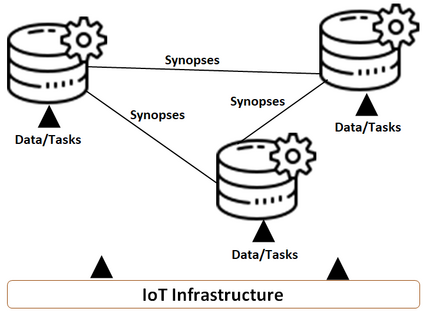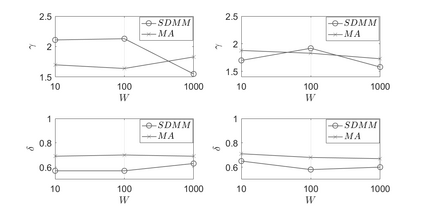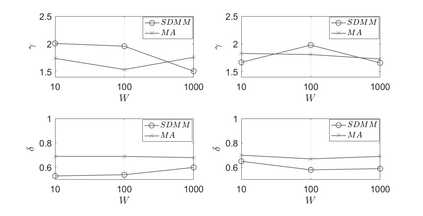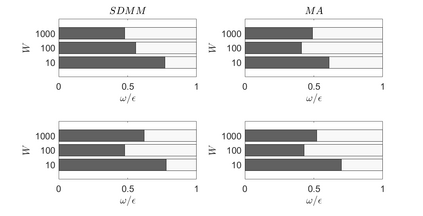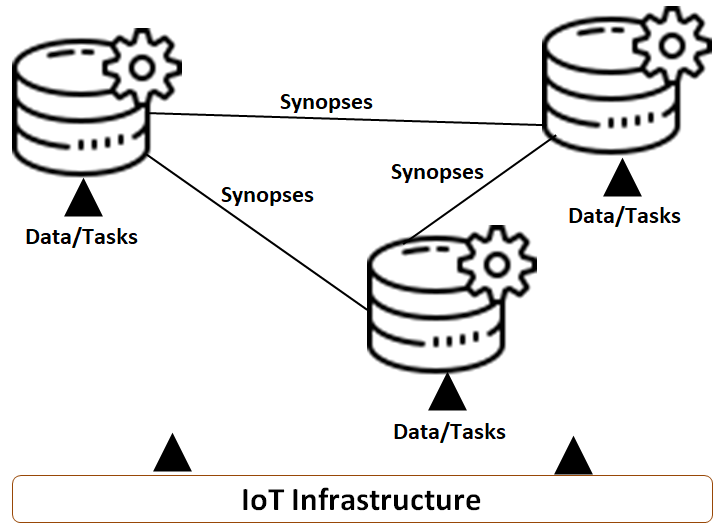The combination of the infrastructure provided by the Internet of Things (IoT) with numerous processing nodes present at the Edge Computing (EC) ecosystem opens up new pathways to support intelligent applications. Such applications can be provided upon humongous volumes of data collected by IoT devices being transferred to the edge nodes through the network. Various processing activities can be performed on the discussed data and multiple collaborative opportunities between EC nodes can facilitate the execution of the desired tasks. In order to support an effective interaction between edge nodes, the knowledge about the geographically distributed data should be shared. Obviously, the migration of large amounts of data will harm the stability of the network stability and its performance. In this paper, we recommend the exchange of data synopses than real data between EC nodes to provide them with the necessary knowledge about peer nodes owning similar data. This knowledge can be valuable when considering decisions such as data/service migration and tasks offloading. We describe an continuous reasoning model that builds a temporal similarity map of the available datasets to get nodes understanding the evolution of data in their peers. We support the proposed decision making mechanism through an intelligent similarity extraction scheme based on an unsupervised machine learning model, and, at the same time, combine it with a statistical measure that represents the trend of the so-called discrepancy quantum. Our model can reveal the differences in the exchanged synopses and provide a datasets similarity map which becomes the appropriate knowledge base to support the desired processing activities. We present the problem under consideration and suggest a solution for that, while, at the same time, we reveal its advantages and disadvantages through a large number of experiments.
翻译:互联网“事物”(IoT)所提供的基础设施与在边缘计算(EC)生态系统中存在的众多处理节点相结合,这为支持智能应用开辟了新的途径。这些应用可以在通过网络传输到边缘节点的IoT设备所收集的大量数据传输到网络的边缘节点时提供。可以在讨论的数据上开展各种处理活动,EC节点之间的多种合作机会可以促进执行预期任务。为了支持边缘节点之间的有效互动,应当共享关于地理分布数据的知识。很显然,大量数据迁移将损害网络稳定性及其性能。在本文件中,我们建议交换数据组合比EC节点之间真实数据收集的大量数据,以提供有关拥有类似数据的同行节点的必要知识。在考虑诸如数据/服务迁移和任务卸载等决定时,这种知识是有价值的。我们描述一个连续的推理模型,为现有数据集建立时间相似的地图地图图,以了解同行数据的演变情况。我们支持拟议的决策机制,通过一个智能相似的相似的模型来显示其深度的模型,我们通过一个相似的模型来显示其深度的变差,我们可以通过一个我们的数据变差的模型来显示一个我们的数据变距的模型。

